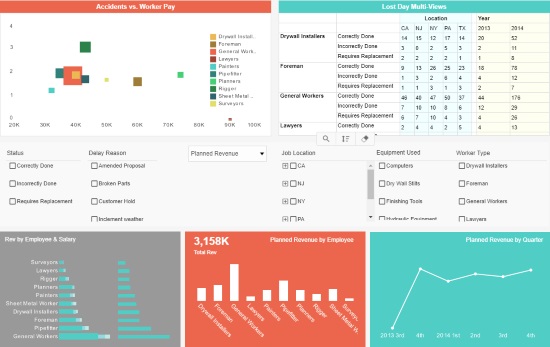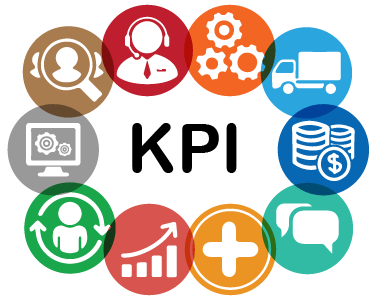Are There “Soft” and “Hard” KPIs?
This is a continuation of a transcript of a Webinar hosted by InetSoft entitled "Designing a Good Dashboard." The speaker is Mark Flaherty, CMO at InetSoft.
Mark Flaherty (MF): Yes, it very much depends on what KPI are measuring. You can have certain soft metrics where you relying on people’s experience. You need to have outside factors that you weigh in, and then you discuss it. And then there are certain very hard KPIs like warehouse metrics, which are very precise, and there can be grave consequences, if you cross a certain threshold. So I think it’s depends very much on what the contact is. But I think this distinction almost doesn’t matter. I think what matters most is that it’s the proper KPI for the person who’s doing his job. Their job is they got experience for the other factors they can bring in the picture.
We talk about the drill down. A lot of the KPIs are rolled up. So you are looking at a number that is the aggregate of hundreds of other things. By definition, that is not a discrete number. So often if that metric goes above or below the threshold, you have to take a closer look. A good dashboard will allow you to go to a certain level to do what we call micro analytics. We are not getting down the level of statistical analytics, but they allow the user to do the appropriate task to answer the question, and if they need more information then they refer back to BI analyst list to do all that sophisticated analysis.
What are the best practices for reviewing the KPIs in an organization?
This is business strategy. There will be a set of 5 or 6 KPIs that might never change. They should be part of the corporate culture. These reflect the company’s goals. Here is what is important for my division. Here is what important for my role.
And be confident those things will not change over the course of a week. They may change the course of a quarter or maybe a year, but those truths, or those goals, if it’s a mature company, those will be very static.

What KPIs Are Used by Zookeepers?
1. Animal Welfare and Health KPIs
Zookeepers prioritize the well-being of animals in their care, using these KPIs to track health, behavior, and veterinary needs.
- Daily Health Checks Completed (%) – Ensures routine observations are conducted to identify health concerns.
- Animal Weight Monitoring Compliance (%) – Tracks whether animals maintain a healthy weight over time.
- Incidents of Illness or Injury (Per Month/Year) – Measures the frequency of health issues requiring veterinary intervention.
- Veterinary Visit Compliance Rate (%) – Ensures scheduled check-ups and vaccinations are completed.
- Enrichment Activities per Species (Per Week) – Evaluates the frequency of mental and physical stimulation activities provided.
- Stress Behavior Incidents (Per Animal/Month) – Tracks unusual behaviors indicating distress, such as pacing or aggression.
2. Habitat and Facility Maintenance KPIs
A well-maintained habitat is critical for animal welfare and public perception.
- Daily Cleaning Tasks Completed (%) – Tracks the completion of scheduled cleaning routines.
- Water and Food Quality Tests Compliance (%) – Ensures proper nutrition and hydration.
- Number of Habitat Repairs or Maintenance Requests – Monitors facility upkeep and responsiveness.
- Temperature and Humidity Compliance (%) – Measures environmental conditions against ideal ranges for species.
3. Conservation and Breeding Program KPIs
Zookeepers involved in conservation efforts track these KPIs to measure success in species preservation.
- Successful Breeding Attempts (%) – Tracks the effectiveness of breeding programs.
- Survival Rate of Offspring (%) – Measures juvenile survival compared to expected benchmarks.
- Participation in Global Conservation Programs (Yes/No) – Indicates active involvement in conservation initiatives.
- Endangered Species Population Growth (%) – Measures progress in increasing at-risk animal populations.
4. Visitor Engagement and Education KPIs
Zoos often have educational goals, and zookeepers may be involved in visitor engagement.
- Number of Educational Programs Held (Per Month/Year) – Tracks zoo-led talks, tours, and school programs.
- Visitor Satisfaction Score (%) – Measures feedback on zookeeper-led experiences.
- Number of Volunteer Hours Logged (Per Year) – Assesses community involvement.
- Social Media Engagement with Zookeeper Content (Likes, Shares, Comments) – Indicates public interest in educational outreach.
5. Operational Efficiency KPIs
Efficient zookeeping is essential for maintaining high standards of animal care.
- Zookeeper-to-Animal Ratio – Ensures proper staffing levels.
- Time Spent per Animal (Hours per Day/Week) – Measures hands-on care and observation time.
- Budget Adherence (%) – Tracks expenses related to food, medical care, and enrichment materials.
- Inventory Accuracy for Food and Medical Supplies (%) – Ensures adequate stock levels without excessive waste.
| Previous:Interoperable and Dynamic Dashboards |
